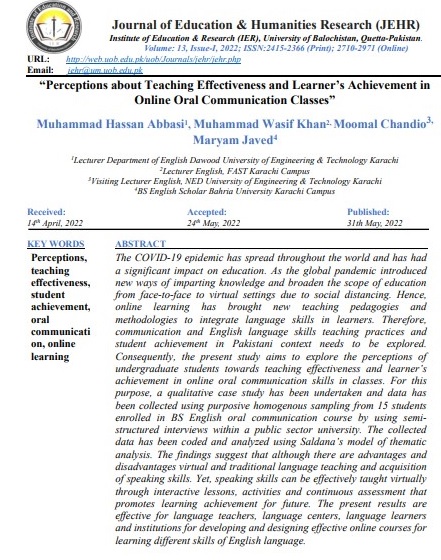Perceptions about Teaching Effectiveness and Learner’s Achievement in Online Oral Communication Classes
Keywords:
Perceptions, teaching effectiveness, student achievement, oral communication, online learningAbstract
The COVID-19 epidemic has spread throughout the world and has had a significant impact on education. As the global pandemic introduced new ways of imparting knowledge and broaden the scope of education from face-to-face to virtual settings due to social distancing. Hence, online learning has brought new teaching pedagogies and methodologies to integrate language skills in learners. Therefore, communication and English language skills teaching practices and student achievement in Pakistani context needs to be explored. Consequently, the present study aims to explore the perceptions of undergraduate students towards teaching effectiveness and learner’s achievement in online oral communication skills in classes. For this purpose, a qualitative case study has been undertaken and data has been collected using purposive homogenous sampling from 15 students enrolled in BS English oral communication course by using semi-structured interviews within a public sector university. The collected data has been coded and analyzed using Saldana’s model of thematic analysis. The findings suggest that although there are advantages and disadvantages virtual and traditional language teaching and acquisition of speaking skills. Yet, speaking skills can be effectively taught virtually through interactive lessons, activities and continuous assessment that promotes learning achievement for future. The present results are effective for language teachers, language centers, language learners and institutions for developing and designing effective online courses for learning different skills of English language.
References
Alharbi, H. A. (2015). Improving Students' English Speaking Proficiency in Saudi Public Schools. International Journal of Instruction, 8(1), 105-116. https://doi.org/10.12973/iji.2015.818a
Ally, M. (2004). Foundations of educational theory for online learning. Theory and practice of online learning, 2, 15-44.
Alsaedi, A. (2012). The teaching of EFL speaking in developed secondary public schools for females in Saudi Arabia: A case study, (Unpublished doctoral dissertation). University of Southampton, Southampton, UK.
Alwamleh, M.,Al-Twait, L.M.,& Al-Saht, G.R. (2020). The effect of online learning on communication between instructors and students during Covid-19 pandemic. Asian Education and Development Studies. https://doi.org/10.1108/AEDS-06-2020-0131
Alzamil, (2021). Teaching English Speaking Online versus Face-to-Face: Saudi Students’ 12 (1), Arab World English Journal (AWEJ), 12 (1), 19-27. https://dx.doi.org/10.24093/awej/vol12no1.2
Apriyana, Desi (2021). Students’ Perception of using Google Meet for Speaking Skills in Online Learning during Covid-19 Pandemic at the Twelfth Grade Students of SMAN 3 Jamb in Academic Year 2020/2021. University of Batanghari, Jambi.
Boling, E.C., Hough, M., Krinsky, H., Saleem, H. & Stevens, M. (2012). Cutting the distance in distance education: perspectives on what promotes positive, online learning experiences”, The Internet and Higher Education, 15(2), 118-126.
Benson, A.D. (2002). Using online learning to meet workforce demand: a case study of stakeholder influence, Quarterly Review of Distance Education, 3(4), 443-452.
Caner, M. (2012). The definition of blended learning in higher education. In Panagiotes, S. and Anastasiades (Eds), Blended Learning Environments for Adults: Evaluations and Frameworks, IGI Global, New York, pp. 19-34.
Conrad, D. (2002). Deep in the hearts of learners: insights into the nature of online community. The Journal of Distance Education, 17(1), 1-19.
Creswell, J. (2012). Educational Research: Planning, Conducting, and Evaluating Quantitative and Qualitative Research. New York: Pearson
Duff, A.P. (2008). Case Study Research in Applied Linguistics. New York: Lawrence Erlbaum Associates.
Fedynich, L.V. (2013). Teaching beyond the classroom walls: the pros and cons of cyber learning. Journal of Instructional Pedagogies, 13, 1-7.
Fansury, A. H., Januarty, R., & Ali Wira Rahman, S. (2020). Digital Content for Millennial Generations: Teaching the English Foreign Language Learner on COVID-19 Pandemic. Journal of Southwest Jiaotong University, 55(3), 1-12. https://doi.org/10.35741/issn.0258-2724.55.3.40
Fulcher, G. (2003). Testing Second Language Speaking. Harlow: Pearson Education.
Ferdig, R. E., Baumgartner, E., Hartshorne, R., Kaplan-Rakowski, R., & Mouza, C. (2020). Teaching, technology, and teacher education during the covid-19 pandemic: Stories from the field. Waynesville, NC, USA: Association for the Advancement of Computing in Education (AACE).
Getange, K.N. (2016). Motivational strategies and teachers’ productivity: lessons of experience frompublic secondary schools in Kisii County, Kenya. IOSR Journal of Research and Method in Education, 6 (4), 33-38.
Hamad, M. M. (2013). Factors Negatively Affect Speaking Skills at Saudi Colleges for Girls in the South. English Language Teaching, 6(12), 87-97. https://doi.org/10.5539/elt.v6n12p87
Kear, K. (2010). Social Presence in Online Learning Communities, Proceedings of the 7th International Conference on Networked Learning 2010, 3-4 May 2010, Aalborg, Denmark.
Kupczynski, L., Brown, M. & Davis, R. (2008). The impact of instructor and student interaction in internet based courses. Journal of Instruction Delivery Systems, 22 (1), 6-11.
Majeed, A. (2019). Developing Speaking Skills and fluency of ESL students through Task-Based Teaching. An Unpublished thesis MS thesis, Department of Humanities, NEDUET.
Morrison, G.R., Ross, S.J., Morrison, J.R. & Kalman, H.K. (2019). Designing Effective Instruction John Wiley & Sons, New York.
Nunan, D (1992). Research Methods in Language Learning. Cambridge University Press.
Paechter, M., & Maier, B. (2010). Online or face-to-face? Students' experiences and preferences in e-learning. The internet and higher education, 13(4), 292-297. https://doi.org/10.1016/j.iheduc.2010.09.004
Sellnow-Richmond, D., Strawser, M. G., & Sellnow, D. D. (2020). Student perceptions of teaching effectiveness and learning achievement: A comparative examination of online and hybrid course delivery format. Communication Teacher, 34(3), 248-263.
Stake, R. E. (2003). Case studies. In N. K. Denzin and Y. S. Lincoln (eds.) Strategies of Qualitative Inquiry (2nd Ed.). London: Sage.
Saldaña, J. (2009). The coding manual for qualitative researchers. London: Sage.
Vonderwell, S. (2003). An examination of asynchronous communication experiences and perspectives of students in an online course: a case study. The Internet and Higher Education, 6. (1), 77-90.




